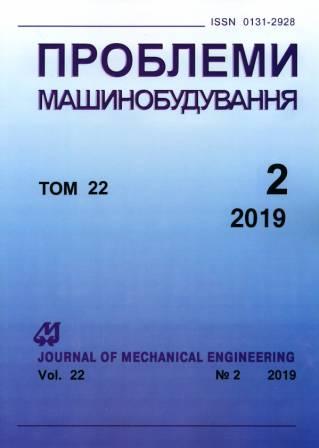Thermal and Stress State of the Steam Turbine Control Valve Casing, with the Turbine Operation in the Stationary Modes
Keywords:
steam flow, steam distribution system, thermal stress state, valve casingAbstract
The purpose of this paper is to determine the most stressful zones and assess the possibility of plastic deformations of the control valve casing in its crack forma-tion zones, with the K-325 steam turbine operation in the stationary modes. The problem is solved in two stages. First, the steam flow characteristics in the steam distribution system and the casing temperature are determined. Then, the elastic stress-strain state of the casing of one of the two valve units (through which the steam consumption is always greater than through the other) is esti-mated using the values of the casing temperature field. The characteristics of steam flow in the steam distribution system and the thermal state of the control valve casing are determined numerically by the finite element method. The steam flow rates, temperature and pressure on the casing wall are determined based on the solution to the Navier-Stokes equation in a three-dimensional for-mulation. It is established that the steam temperature before the turbine control valves is practically the same as the one before the stop valve. In the casing itself, after the control valves, with the valves partially open, a significant drop in steam temperature may occur due to throttling. A significant decrease in the steam temperature in the control valve (by 100 °C) is observed at low power with a nominal vapor pressure after the boiler. The calculation of the elastic stress-strain state of the control unit casing was carried out using the finite element method based on the three-dimensional mathematical model for casing deformation. As a result, the stress state of the valve casing was obtained for the different operating modes of the turbine. It is shown that differences in stresses for different modes are associated with changes in the thermal state of the valve casing and the distribution of pressure on its walls. Zones of possible plastic deformations of the valve casing are established. In those zones, the elastic stresses exceed the yield strength of the material. The obtained results clearly show that the most dangerous mode in terms of the control valve casing static strength is not the turbine nominal mode of operation at a power of 320 MW, but a part-load operation mode, at 180 MW.References
Plotkin, Ye. R. & Leyzerovich, A. Sh. (1980). Puskovyye rezhimy parovykh turbin energoblokov [Start-up modes of steam turbines of power units].Moscow: Energiya, 192 p. (in Russian).
Zaryankin, A. Ye. & Simonov B. P. (2005). Reguliruyushchiye i stoporno-reguliruyushchiye klapana parovykh turbin [Regulating and stop-regulating valves of steam turbines].Moscow: Moscow Power Engineering Institute, 360 p. (in Russian).
Menter, F. R. (1997). Eddy viscosity transport equations and their relation to the k–ε model. ASME Journal of Fluids Engineering, vol. 119, no. 4, pp. 876–884. https://doi.org/10.1115/1.2819511
Kolyadyuk, A. S., Shulzhenko, N. G., & Babayev, I.N. (2011). Chislennoye modelirovaniye techeniya para v regulirovochnom klapane turbiny [Numerical simulation of steam flow in a turbine control valve]. Vestnik dvigatelestroyeniya – Engine Building Bulletin, no. 2, pp. 106–110 (in Russian).
Kolyadyuk, A. S., Shulzhenko, N. G., & Yershov, S. V. (2012). Techeniye para i raspredeleniye temperatury v sisteme paroraspredeleniya turbiny dlya razlichnykh rezhimov yeye raboty [Steam flow and temperature distribution in the steam distribution system of a turbine for various modes of its operation]. Aviatsionno-kosmicheskaya tekhnika i tekhnologiya – Aerospace Technic and Technology, no. 7, pp. 85–90 (in Russian).
Shulzhenko, N. G. & Kolyadyuk, A. S. (2014). Otsenka polzuchesti korpusa reguliruyushchego klapana parovoy turbiny K-325 [Evaluation of the creep of the control valve body of the K-325 steam turbine]. Visnyk NTU «KhPI». Seria Enerhetychni ta teplotekhnichni protsesy y ustatkuvannia – Bulletin of the NTU "KhPI": Power and Heat Engineering Processes and Equipment, no. 11, pp. 125–131 (in Russian).
PNAE G-7-002-86 (1987). Normy rascheta na prochnost oborudovaniya i truboprovodov atomnykh energeticheskikh ustanovok [Rules and regulations in the nuclear power industry PNAE G-7-002-86. Standards for strength calculation of equipment and pipelines of nuclear power plants]. USSR State Committee for Supervision of the Safety of Work in Industry and Atomic Energy. Moscow: Energoatomizdat, 525 p. (in Russian).
Downloads
Published
Issue
Section
License
Copyright (c) 2019 Andrii S. Koliadiuk, Mykola H. Shulzhenko

This work is licensed under a Creative Commons Attribution-NoDerivatives 4.0 International License.
All authors agree with the following conditions:
- The authors reserve the right to claim authorship of their work and transfer to the journal the right of first publication of the work under the license agreement (the agreement).
- Authors have a right to conclude independently additional agreement on non-exclusive spreading the work in the form in which it was published by the jpurnal (for example, to place the work in institution repository or to publish as a part of a monograph), providing a link to the first publication of the work in this journal.
- Journal policy allows authors to place the manuscript in the Internet (for example, in the institution repository or on a personal web sites) both before its submission to the editorial board and during its editorial processing, as this ensures the productive scientific discussion and impact positively on the efficiency and dynamics of citation of published work (see The Effect of Open Access).

